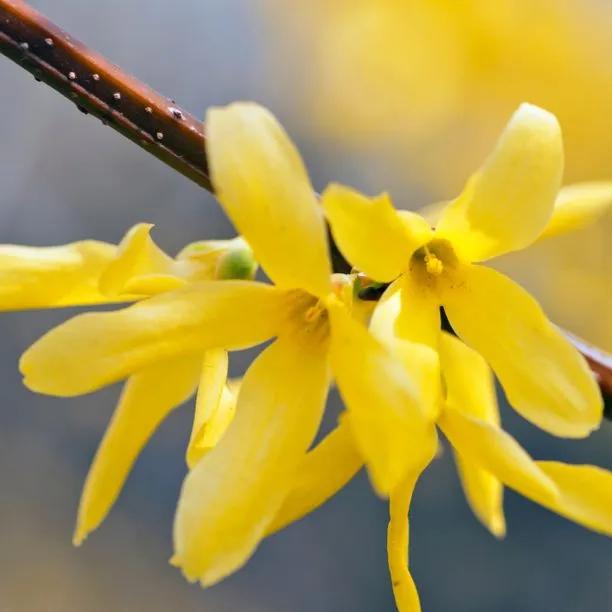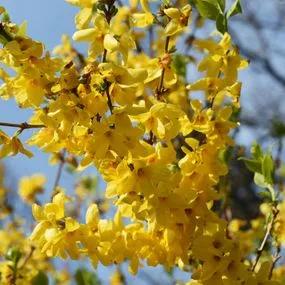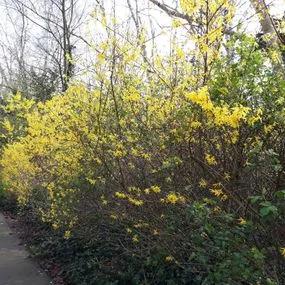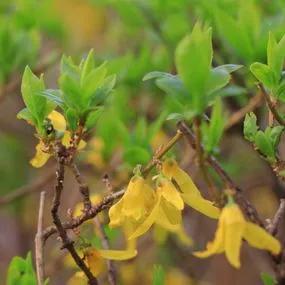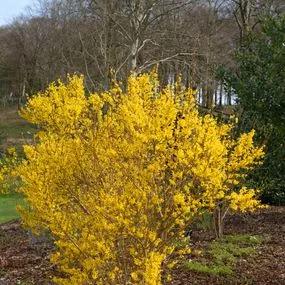Spectabilis Forsythia Hedge Plants
Honest Delivery PricesForsythia intermedia Spectabilis
Hedge Plants- Great specimen / flowering hedge
- Soil: Any fertile & well drained, likes chalk.
- Mass of yellow flowers in Mar-Apr
- Bareroot Delivery Only: Nov-Mar.
Recommended extras
Description
Forsythia Intermedia Spectabilis Hedging
Delivered by Mail Order Direct from our Nursery with a Year Guarantee
Forsythia intermedia Spectabilis is the most widely grown variety of Forsythia. It makes a wonderful early spring specimen shrub as it is covered in the most gorgeous golden yellow blossom in March and April, lighting up gardens wherever it is grown. It can grow to 4 metres in ideal conditions. For other spring choices, have a look at our full range of hedging.
We only deliver Forsythia barerooted, so delivery is during the planting months of November - April. The sizes are in centimetres above the ground (the roots don't count).
Features:
- Specimen shrub or flowering hedge
- Exceptional yellow flowers in March/April
- Simple green foliage in summer, pale bark in winter
- Max Height 4m, can be pruned low.
- Any soil in close to full sun.
Growing Forsythia
Its beauty is unfussy, and it will grow in most soils and in any location providing it gets sun.
Spacing Forsythia:
As a specimen plant, it likes a bit of room to let it get to full size so allow about a 2m width, although with pruning you can get away with a bit less.
As a flowering hedge, you would plant at 2-3 plants per metre, 33-50cm apart.
If you have the room, grow it in a mixed border or shrubbery and if you are worried that it might look a bit plain after it's flowered, try using it as a host for a smaller clematis which can ramble through its branches and flower, depending on variety, from May onwards.
Underplant the base with snowdrops and you have a 6-8 month show. Fabulous.
Did You Know?
Forsythia x intermedia is a hybrid of F. suspensa and F. viridissima. This particular cultivar was discovered in 1906.
Planting Instructions
Growing Forsythia plants:
Once it is established, your plants will do well in the dry, poor soil which is often found next to houses. They don't like wet soil or deep shade - half a day of full sun is enough.
Prepare your site before planting:
It is good to dig over the area where you plant a hedge several months in advance, especially if the soil is poor. Destroy the weeds first. Then dig the soil over; remove rocks, roots and other rubbish. Mix in well rotted compost or manure down to the depth of about 2 spades. If your soil is rich, you don't have to dig it over, but killing all the weeds is still necessary.
Watch our video on how to plant a garden hedge for full details. The plants in this video are delivered pot-grown, but planting out bareroot stock is essentially the same.
Remember to water establishing plants during dry weather for at least a year after planting.
Hedge Planting Accessories:
Prepare your site for planting by killing the weeds and grass.
You can buy a hedge planting pack with sheets of mulch fabric and pegs to hold it down.
If you are planting in an area with rabbit and/or deer, you will need to use a plastic spiral guard for each plant, supported by a bamboo cane.
If your soil quality is poor, we recommend using mycorrhizal "friendly fungi" on the roots of new trees and shrubs.
You can also improve your soil with bonemeal organic fertiliser.
After Care
After you have planted your Forsythia hedge, the most important thing to do is water it in dry weather. You will also need to weed around the plants. Watering should be thorough, so the ground is soaked. Let the soil almost dry out before watering again. Watering & weeding will be necessary for at least a year after planting.
Trimming Forsythia hedge plants:
Forsythia doesn't need any clipping at all in its first year. In the winter of the year after planting, your young hedge should be trimmed lightly and every winter after that until it is mature.
When it is fully grown, clip it after flowering in spring & again in late summer.
Special notes on caring for Forsythia hedges:
Forsythia is a tough hedge plant that shouldn't need special attention once it has established. If you didn't use a mulch fabric, it is beneficial to mulch around the base of the hedge each year.
Hygiene & Diseases:
Dead, damaged or diseased wood can be pruned off as soon as it appears.
Disinfect your pruning tools between every cut if there is any sign of disease.
Burn or dispose of any diseased material, do not compost it.
After you have planted your Forsythia hedge, the most important thing to do is water it in dry weather. You will also need to weed around the plants. Watering should be thorough, so the ground is soaked. Let the soil almost dry out before watering again. Watering & weeding will be necessary for at least a year after planting.
Trimming Forsythia hedge plants:
Forsythia doesn't need any clipping at all in its first year. In the winter of the year after planting, your young hedge should be trimmed lightly and every winter after that until it is mature.
When it is fully grown, clip it after flowering in spring & again in late summer.
Special notes on caring for Forsythia hedges:
Forsythia is a tough hedge plant that shouldn't need special attention once it has established. If you didn't use a mulch fabric, it is beneficial to mulch around the base of the hedge each year.
Hygiene & Diseases:
Dead, damaged or diseased wood can be pruned off as soon as it appears.
Disinfect your pruning tools between every cut if there is any sign of disease.
Burn or dispose of any diseased material, do not compost it.

